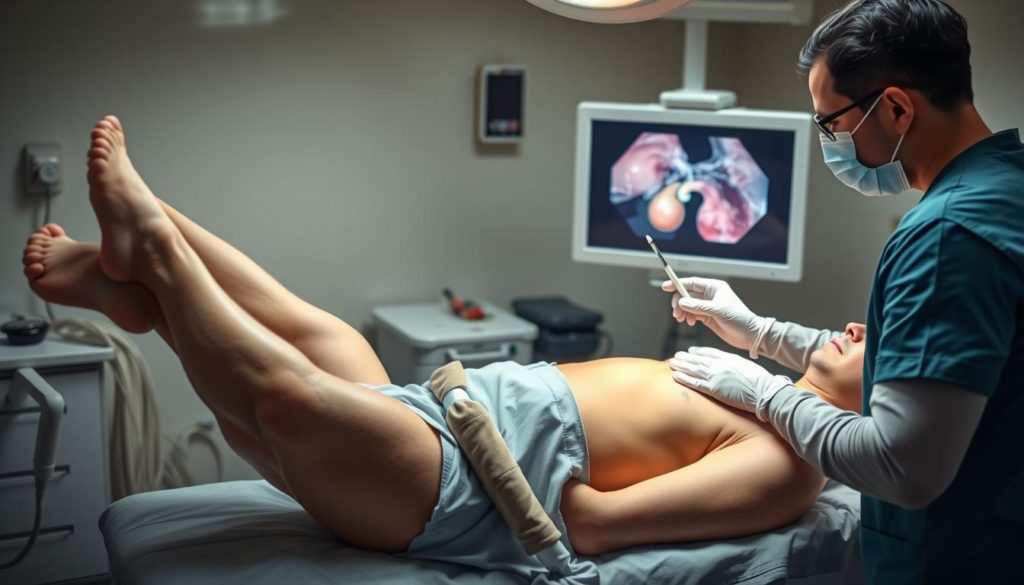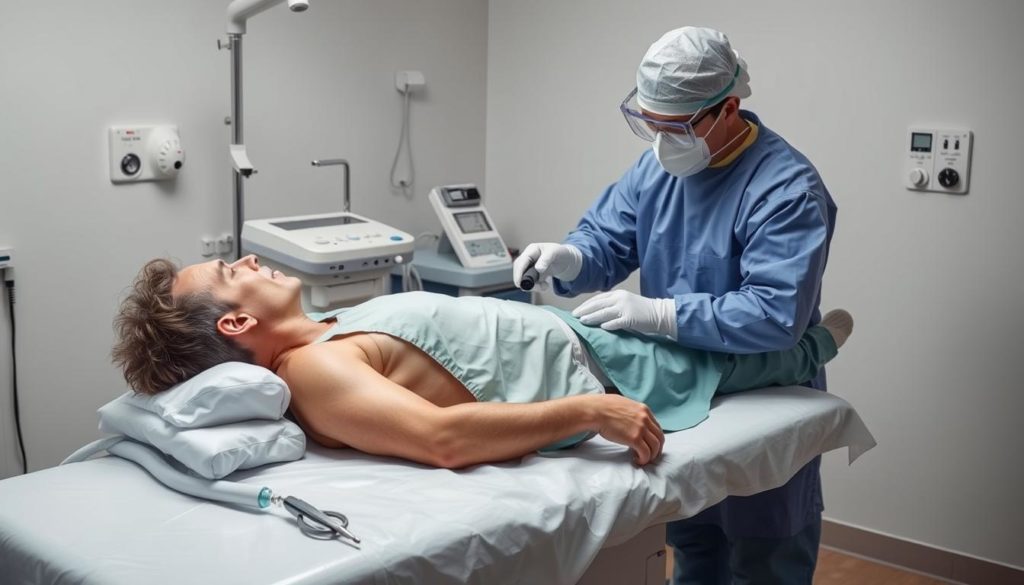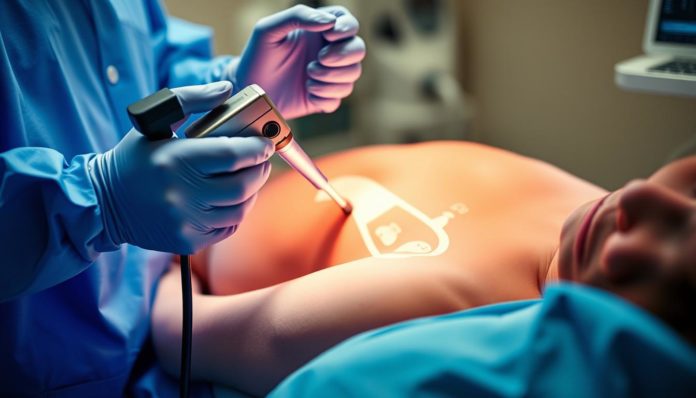Did you know that over 500,000 cystoscopy procedures are performed in the United States each year? This test is crucial for checking bladder health. It plays a big role in examining the urinary system.
A cystoscopy lets doctors look inside your urethra and bladder with a special tool called a cystoscope. This check-up helps find and sometimes fix problems. It’s used for issues like blood in urine, frequent infections, and pain.
Understanding the cystoscopy process is important. It helps whether you’re in pain or just getting a regular check-up. It’s key for keeping your urinary system healthy.
What is a Cystoscopy?
A cystoscopy is a key procedure in urology to check the bladder and urethra. Doctors use a cystoscope, a device with a camera and light, for a clear view inside. It’s crucial for finding problems in the urinary tract.

Overview of the Procedure
Patients go through a cystoscopy as an outpatient, so staying in the hospital isn’t needed. The scope is gently put through the urethra to the bladder. Its slim build causes little discomfort while letting doctors fully examine the bladder wall.
This check-up helps spot polyps, narrow spots, and unusual growths early. Catching these early is key for tackling health issues quickly.
Purpose and Uses
Cystoscopies are vital for diagnosing and treating in urology. Uses include:
- Diagnosing causes of recurring UTIs
- Finding the reason for blood in the urine
- Keeping an eye on bladder cancer
- Looking into bladder control or urine holding problems
This technique’s detailed information helps in planning the right treatment. It plays a big role in protecting the patient’s health. That’s why cystoscopies are fundamental in urology today.
Why a Cystoscopy is Performed
A cystoscopy is crucial for checking bladder and urinary tract problems. It lets doctors see inside directly, which helps in deciding how to treat the patient.
Common Reasons for the Test
Doctors often suggest this test if you find blood in your urine. It’s also for those with an overactive bladder, leaky bladder, or pain when peeing. Plus, it looks into frequent urinary tract infections.
Diagnostic Applications
A cystoscopy is key in finding bladder diseases. It allows doctors to closely look at the urinary tract. This helps spot issues like bladder cancer, cystitis, and big prostate glands. A detailed check-up means quicker and more accurate diagnosis.

Therapeutic Applications
But it’s not just for diagnosis. This procedure also helps treat problems. It can remove small tumors, fix bladder stones, and ease bladder inflammation during the exam. It’s also important for checking prostate health, especially when it’s enlarged.
Below is a table that sums up what a cystoscopy can do:
| Application | Description |
|---|---|
| Diagnostic | Bladder disease diagnosis, urinary tract examination, prostate health evaluation |
| Therapeutic | Removal of bladder tumors, treatment of bladder stones, resolution of cystitis |
Types of Cystoscopes
In a cystoscopy, the type of medical scope used is crucial for both results and comfort. There are mainly two types: rigid and flexible. Each serves different purposes, whether it’s checking bladder health or performing a diagnostic test in urology.
Rigid Cystoscope
A rigid cystoscope is often chosen for surgeries inside the bladder. It’s good for precise work like biopsies or removing tumors. Because it’s stiff, patients might need sedation or anesthesia to lessen any discomfort. This scope offers better control for complex tasks, leading to its preference for certain treatments.
Flexible Cystoscope
For checking a patient’s bladder, a flexible cystoscope is usually used. It bends easily, which lets it go smoothly through the urethra into the bladder, causing less discomfort. It’s great for a thorough look at the bladder and urinary tract. Outpatient clinics commonly use it, and often, patients don’t need anesthesia.
Choosing the Right Type for Your Procedure
Choosing between a rigid and flexible cystoscope depends on the urology test needed. A rigid one is better for complex surgeries needing high precision. But for regular diagnostics and simpler checks, the flexible one is preferred because it’s easier on the patient. Always talk to your healthcare provider to pick the best scope for your situation.
Preparing for a Cystoscopy
Getting ready for a cystoscopy involves *pre-cystoscopy preparation*. Making sure the *urinary system* examination flows well. Knowing the *medical procedure guidelines* helps calm nerves.
Pre-Procedure Instructions
Patients need to empty their bladder before the cystoscopy. They should also take off any clothes or jewelry that could get in the way. Talking about medications with the doctor is important too.
Those needing general anesthesia must not eat beforehand. It’s also important to have someone ready to drive you home. This is because you might have had sedatives or anesthesia.
What to Expect Before the Test
Part of getting ready includes talking deeply with the doctor. This talk is about the process. It’s vital for understanding the *medical procedure guidelines*.
Making sure you’re prepared for sedatives or anesthetics is key. A good understanding and prep lead to a successful evaluation of the *urinary system*. So, good preparation is crucial.
The Cystoscopy Procedure
The cystoscopy process is an important test for checking the bladder and urinary tract. Here’s a simple explanation of how doctors usually do this quick procedure.
Step-by-Step Explanation
First, the patient lies on their back, sometimes with knees up and apart if a rigid cystoscope is used. They receive anesthesia or a sedative to help them relax. Next, the doctor puts the cystoscope through the urethra into the bladder.
A sterile solution is then used to fill and expand the bladder. This makes it easier to see inside.
What Happens During the Test
With the cystoscope in place, the doctor looks at the bladder lining and urethra. They use imaging to spot any oddities. Sometimes, they might take tissue samples for more tests. This careful checking helps give clear results from the cystoscopy.
Duration of the Procedure
This urology test is fairly fast, taking about 5 to 30 minutes. The time it takes can change, especially if a biopsy is done. But overall, it’s a quick, effective way to check the urinary tract for issues.
What to Expect After a Cystoscopy
Having a cystoscopy can make you nervous. Yet, knowing how to care for yourself after it helps you recover smoothly. This part shares important info on what happens right after and days following the procedure.
Immediate Post-Procedure Care
After the cystoscopy, it’s key to follow post-cystoscopy care steps to lessen pain and help your bladder heal. If you were given sedation or anesthesia, don’t drive, use machines, or drink alcohol for 24 hours.
- Drink a lot to clean your bladder and reduce any bleeding.
- Take pain relievers from the store if you need them.
- Put something warm on your lower belly to ease pain.
Long-Term Recovery
Most people’s bladder health gets better quickly, feeling good in a few days. During recovery, remember to:
- Keep drinking water to help your bladder heal.
- Don’t do hard activities for a bit, following your doctor’s advice.
- Tell your doctor right away if you have ongoing issues or concerns.
| Immediate Care | Long-Term Recovery |
|---|---|
| Increase fluid intake | Stay hydrated |
| Avoid driving and alcohol | Avoid strenuous activities |
| Use pain relief medications | Monitor for persistent symptoms |
| Apply warmth for discomfort | Consult healthcare provider if needed |
Risks and Complications
Every medical procedure, including cystoscopy, has its risks and potential complications. It’s crucial for patients to know these risks. They should also know when to get medical help.
Common Risks
Most patients face minor problems after a cystoscopy. Common cystoscopy complications are:
- Infections
- Bleeding
- Discomfort during urination
Usually, these can be handled easily. Drinking lots of water and taking simple painkillers often helps.
Serious Complications
Severe medical procedure risks from cystoscopies are rare:
- Kidney injury
- Hyponatremia
- Bladder wall rupture
These serious risks don’t happen often. But they are important to know about.
When to Seek Medical Attention
After the procedure, patients should watch their health closely. They need to see a doctor right away if they have bad pain, fever, chills, or trouble peeing. Catching and treating these symptoms early can avoid bigger health problems.
Cystoscopy Bladder Prostate Test: A Detailed Look
A cystoscopy bladder prostate test is key for checking the urinary tract’s lower parts. It gives a clear view, helping to find and treat bladder and prostate issues.
This test lets doctors quickly spot problems like infections, bladder cancer, or enlarged prostate. They use a special scope with a lens to see the bladder and prostate up close. This way, they can catch issues early and increase the odds of successful treatment.
During the test, a cystoscope’s high-tech lens shows clear pictures of the bladder and urethra. Doctors can see exactly where any problems are. This test is both for finding and treating health concerns, showing how important it is in medicine.
In conclusion, this test is vital in urology today. By carefully examining the area, it helps experts find the cause of urinary problems. This leads to better treatments.
Diagnosing Bladder and Urinary Tract Issues
Cystoscopy is key for identifying bladder and urinary tract issues. It lets doctors see inside your body. This helps them find and treat problems accurately.
Bladder Infections and Cystitis
Doctors can confirm bladder infections, like cystitis, using cystoscopy. It reveals signs of inflammation and infection. This gives deep insights into urinary tract health.
Bladder Cancer Detection
Cystoscopy is crucial for spotting bladder cancer early. It shows any unusual growths or tumors. Early discovery helps start treatments soon, improving survival rates.
Other Urinary Tract Conditions
Cystoscopy also finds other urinary tract problems. It can spot things like urethral strictures and urinary stones. This ensures a full check-up of urinary health.
| Condition | Diagnosed Through | Importance |
|---|---|---|
| Bladder Infections | Cystoscopy, Urinalysis | Accurate diagnosis and timely treatment |
| Bladder Cancer | Cystoscopy, Biopsy | Early detection and improved outcomes |
| Urethral Strictures | Cystoscopy, Imaging Tests | Precise treatment planning |
Benefits of Cystoscopy
Cystoscopy is a key tool for urologists today. It helps diagnose and treat bladder and urinary tract problems. It’s known for accurate diagnoses, effective treatments, and being minimally invasive.
Accurate Diagnosis
Cystoscopy stands out for giving an accurate urinary diagnosis. It lets doctors see inside the bladder and urethra. They can spot things like tumors, stones, or infections quickly. This means patients get a correct diagnosis fast, leading to the right treatment sooner.
Effective Treatment Options
Cystoscopy also opens the door to many treatments. It can remove bladder tumors, clear blockages, or tackle infections that other treatments can’t. Doctors can treat problems directly, often in one procedure. This cuts down on the need for more treatments.
Minimally Invasive Nature
The procedure’s minimally invasive nature is a big benefit. It uses a thin tube with a camera, so it’s not too uncomfortable. Patients face less risk, less pain, and heal quicker. They often don’t need to stay in the hospital. So, they can get back to their lives faster.
The mix of accurate urinary diagnosis, strong treatment options, and a gentle approach shows cystoscopy’s value in urology.
Frequently Asked Questions
When talking about cystoscopy FAQs, many want to know if it hurts. It’s okay to worry. Yet, most people only feel a little uncomfortable. Doctors use local anesthesia to numb the area. Sometimes, they might use general anesthesia.
Many people also ask about how long recovery takes. You can usually get back to your activities in a day or two. You might feel a slight burn when you pee, but it goes away fast. Drinking a lot of water helps with this.
Knowing what happens before, during, and after cystoscopy is key. Beforehand, it’s vital to follow your doctor’s instructions. They might ask you to not eat or to change your meds. During the process, a cystoscope is carefully placed into the bladder for checking. After, following care tips from your doctor is crucial for your recovery.
Questions about the tools used in the procedure are common too. Doctors may use a flexible or a rigid cystoscope. The choice depends on what’s needed for your situation. Your doctor will pick the best one for a smooth check-up.
FAQ
What is a cystoscopy?
Cystoscopy is a medical test that lets doctors see inside your bladder and urethra. They use a special tool called a cystoscope for this. It’s important for figuring out and treating urinary problems.
Why might I need a cystoscopy?
If you’re seeing blood in your pee, feeling pain when you pee, getting lots of UTIs, or can’t control your pee, you might need this test. Doctors also use it to check on bladder diseases and prostate health.
What types of cystoscopes are there?
Doctors use two kinds of cystoscopes. The rigid one is for surgery. The flexible one is for checking things out because it bends and is more comfortable.
How do I prepare for a cystoscopy?
You’ll need to empty your bladder and take off any clothes or jewelry in the way. Talk to your doctor about your meds too. If you’re getting anesthesia, don’t eat beforehand and have someone drive you home.
What happens during the cystoscopy procedure?
The doctor will put the cystoscope in through your urethra up to your bladder. They fill your bladder with a clean solution to see better. They might take some tissue samples. This usually takes about 5 to 30 minutes.
What should I expect after a cystoscopy?
You can mostly go back to your normal day afterward. But if you had sedatives, don’t drink, drive, or use machines for 24 hours. Drink lots of water to help clean out your bladder and ease any soreness or bleeding.
What are the risks and complications of cystoscopy?
This test is usually safe but sometimes can cause infections, bleeding, or pee pain. Very rarely, it can hurt your kidneys or break your bladder wall. If you feel really bad pain, have a fever, or can’t pee, call your doctor right away.
How does cystoscopy help diagnose urinary tract issues?
With cystoscopy, doctors can see your bladder and urethra directly. This helps them find problems like infections, cystitis, or bladder cancer. It’s key for knowing what’s wrong and how to treat it.
What are the benefits of a cystoscopy?
Cystoscopy helps pinpoint problems in your urinary tract and bladder. It can lead to treatments like removing growths. Since it’s not a big surgery, you won’t feel as much discomfort and will recover faster.


